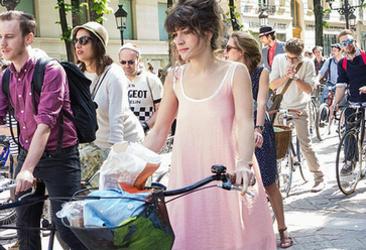
PARIS, France, April 16, 2014 (ENS) – Every year more than 76,600 people would be employed in green and healthy transport and 10,000 lives would be saved if major European cities achieved the same share of cycling as Copenhagen, Denmark, new research reveals.
Employment would increase in the bicycle retail and maintenance sectors, in the provision of clothing and accessories for cyclists, urban development and new mobility plans, according to the research report.

The new findings were released Monday in Paris at the Fourth High-level Meeting on Transport, Health and Environment, hosted by France and organized by the UN Economic Commission for Europe and the World Health Organization’s Regional Office for Europe.
Delegates from European ministries of transport, health and the environment are exploring how innovative transport policies can create employment opportunities, along with healthier and greener societies.
The report, “Unlocking new opportunities: jobs in green and healthy transport,” demonstrates for the first time that investing in cycling not only has positive health and environmental effects, it also can be economically profitable.
Zsuzsanna Jakab, WHO regional director for Europe, said, “An efficient transport system is vital for the functioning of modern economies. However, transport can greatly damage environment and health. That is why we call for a bold Paris Declaration, urging government investments in green and healthy transport.”
“The pay-offs from these investments are enormous and include new jobs and healthier people from more physical activity, fewer road traffic injuries, less noise and better air quality,” said Jakab.
The slogan developed for the meeting, “City in motion: people first!,” underlines the importance of placing citizens at the center of decisions on transport and mobility.
Taking stock of the benefits of physical activity for health and well-being, delegates at the meeting are calling on national governments, municipal authorities and city planners to develop safe and healthy infrastructure for walking and cycling as viable means of urban mobility.

When it discourages physical activity, transport contributes to nearly one million deaths per year, finds the newly published report.
Eva Molnar, director of the UNECE Transport Division, speaking on behalf of Michael Møller, UNECE acting executive secretary, said, “Transport, health and environment form a dynamic nexus of vitality and mobility in our cities, presenting a formidable challenge for sustainability, but also great opportunities for a better quality of life.”
“The Fourth High-level Meeting calls on Member States, civil society and local and regional authorities to support the future vision of the Transport, Health and Environment Pan-European Programme (THE PEP), ‘Green and healthy mobility and transport for sustainable livelihoods for all,'” said Molnar.
THE PEP, run jointly by UNECE and the WHO Regional Office for Europe, addresses basic questions of how best to move around in cities.
The overall costs associated with the environmental and health impacts of transport can be up to four percent of a country’s gross domestic product, the new study shows.
In the WHO European Region outdoor air pollution, largely caused by traffic, results in almost 500,000 deaths annually, according to new evidence in the report.
Road accidents kill 90,000 people prematurely each year, the report also finds. Exposure to excessive street noise affects almost 70 million people. Transport adds 24 percent to total greenhouse gas emissions in Europe and North America.
In Copenhagen, one of the leaders for cycling in Europe, 26 percent of all city trips are undertaken by bicycle. This level is rivaled only by Amsterdam and is much higher than in most other cities in the region.
Through the Paris Declaration, European countries are creating a new vision of green and healthy mobility and transport for sustainable livelihoods for all, linking the promotion of health and sustainability to socioeconomic justice.
This is supported by new goals and tools including: a new priority to integrate transport, health and environmental objectives into urban and spatial planning policies; a pan-European master plan for cycling promotion; the mobilization of young people and youth organizations; and stronger partnerships with city networks, civil society organizations and the research community.
Another publication launched in Paris, “From Amsterdam to Paris and beyond,” showcases success stories from European countries under THE PEP in the last five years.
For instance, France Vélo Tourism launched an online cycling tourism program to plan cycling holidays, guides for cycle tourism, promotion and services, and harmonization of road signs.
The Austrian klima:aktiv mobil managed to reduce around 570,000 tonnes of carbon dioxide emissions a year during 2007–2012 through climate-friendly mobility projects, and created or saved 5,600 green jobs.
Switzerland decreased the transport of heavy goods by road between 2000 and 2012 by almost 14 percent to protect the Alpine region and the health of its inhabitants.
Copyright Environment News Service (ENS) 2014. All rights reserved.
